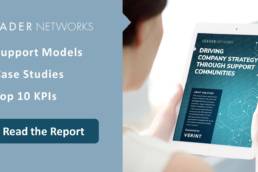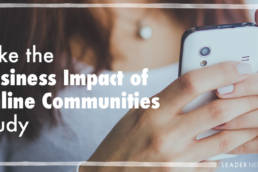What happens when a firm that specializes in supply chain management takes on an online customer community? Will they apply the operational efficiencies found in their line of business to their customer-facing digital initiative? Will workflow be perfected with customer exchanges with the same precision and excellence that good supply chain management is famous for? To find out, I spoke in-depth with Lisa and Jessica, the two leaders of the SPS Commerce online community. Lisa Sacquitne is Product Manager – SPS Commerce. Jessica McDouall is Director, Non Integrated Services – SPS Commerce.
Both Lisa and Jessica were the genius behind the launch and running of this transformative community. SPS Commerce, Inc. headquartered in Minneapolis, Minnesota, SPS Commerce, Inc. is a provider of on-demand supply chain management solutions, providing integration, collaboration, connectivity, visibility and data analytics with revenues that exceed $104M.
Now, onto the interview to learn more. It’s long, but worth the time!
Can you please tell me about your community?
The SPS Commerce support center community was first launched in January, 2013. It is a public community with over 900 registered members and is built on the Get Satisfaction platform. The mission is to create a community where customers can get help, give help and share ideas.
Product management has taken a significant role in the community from collaborating and engaging with customers to sharing product ideas, shaping the ideas into meaningful requirements and scheduling them to be included in future builds of our products.
All of our content is currently public; however, we plan to create private areas in the future. One of the gains from having a public community is that we show our customers we want to be completely transparent with them. We want to make sure if a problem does arise we are able to effectively communicate, acknowledge the problem, and communicate what we are doing to fix it. This transparency is important to our culture. It is really trying to get that culture change within the organization as well to take accountability for when things happen and own the resolution.
How did you get executive level buy-in the launch the community?
Customers expect to be provided with self-service options, and we are looking to scale our business. We use community to marry those two objectives. We did research to understand how we could generate the self-service environment for customers and to answer the important questions such as; How can we promote self-service options without suggesting we are not going to continue to support customers via more traditional support options? We will still answer your calls, emails and chats, but if you would prefer to do things on your own time, we will empower you to answer those questions on your own.
Our starting point was creating the business case and using it to get executive sponsorship and using it to get executive sponsorship. The second thing was to outline measurable goals and metrics that we could use to define success of our community. We rolled community out as a pilot launch where we had six months to determine whether or not it was valuable. Establishing measurable goals is something you need to be able to do in order to speak to the executive team and be able to then show the worth of your community.
Can you share some examples of of the business goals?
I think the biggest goal we had was around customer engagement. In order for community to be successful, we need engagement so we need to make sure that we have good, accurate content available to customers as well.
Cost reduction was not our focus. We are eliminating multiple customer contacts and touch points through community, but are also fielding questions, problems and ideas in the community, so it’s not so much about reducing work or costs, because the work has shifted. It is shifting from reactive work to proactive activities when we seed the community with that content and try to provide answers to questions customers are asking us. The most important question to us is how can we be more proactive in those communications with our customers?
One of the things we are trying to do is not just make the support center a place where people air their grievances or say, “Gosh, I am having trouble,” but it is really a one-stop shop for collaboration, for issue resolution, as well as getting that content out there, the education material about our product. That’s why we have multiple entry points to our community -access it from within the product, from the .com page, and from our private customer portal. We thought we would get the most traffic from within the product, but we are seeing the most traffic coming from our .com site. Customers like not having to log into the customer portal to get their answers.
What is the life of a customer-generated idea when they post it in the community?
Prior to online community, it was a scattered process. Customers would say (through various mediums) “Hey, I’ve got this idea,” and we would jot it down and interpret it a certain way and then we would send it up to product management who may interpret it a different way, and by the time it got implemented it ran the risk of being inadvertently changed or misunderstood.
We wanted to leverage this community as a gathering place for customer feedback, so it was vital for us to get engagement and buy-in from product management. Now we actively promote the community as a primary place to gather ideas from members. For example, if a customer is on the phone with an analyst and they share feedback on how we can make our product better, the analyst encourages the customer to share or post their idea on the support center. Hopefully, the customer would think that was valuable and would go out there and post the idea.
After the idea is posted, one of our support center team members will immediately acknowledge the idea and route it to product management. At that time, product management reviews, acknowledges the idea and directly responds to the customer, usually asking for additional detail or context to really understand their business need. There is usually some back and forth and collaboration.
Other customers may see the conversation and jump in and strengthen it. Then the idea is assessed. It may or may not be added to the product backlog based on the impact of the enhancement, whether or not it aligned with our product strategy. The product manager is then responsible for keeping the group informed as the idea moves through the process.
In customer operations, we want to make sure we are responding to the customers and encouraging them to share their ideas so that they know they are being heard. Product management takes ownership of continuing the conversation, updating the status of that idea and keeping customers in the loop on how the idea is moving forward. We meet with product management on a monthly basis to ensure a community process is built into our relationship.
What was your content strategy for the community in support of customer service?
As part of the pilot, we developed a list of frequently asked questions which became primary community content. We also uploaded a list of requested product features. We pre-populated our community before going live. We answered the frequently asked questions with the best responses from an SPS standpoint. All of the product feature requests were documented, just not in a public format prior to community. We shared the top five to seven product requests from customers for additional feedback. Through this process we have gathered more concrete details through the community, and been able to prioritize future enhancements.
What has been your biggest surprise about the community to date?
We have been surprised by how much our customers have adopted the community. I think our success is because we had a defined project plan and worked across all departments within the company to ensure everyone knew what the community was so that we were all talking the same language. If a customer was talking to their sales person, for example, their sales person is telling them about our fantastic community. If a customer is talking to their support person, their support person has community built into their process. We held multiple training sessions with the people who are responding in the support center and created a handbook documenting best practices and rules of the road. If you are going to be part of this community this is the behavior that we are expecting of you. We also gave people dedicated training who were going to be online within the community answering questions and specified the tone of how to interact with customers before we even got started.
We view the community as a differentiator in terms of our support model. The sales teams have been trained on how they can really use it and help engage existing and new customers as well. The community is helping change and shape the culture of our company. If we see that we can collaborate with our customers, why can we not collaborate internally across departments? It has enabled us to build a stronger relationship between the operations team, marketing product management and sales. Only good things have happened since we launched community and I think it is that energy, that positivity and collaboration with customers and internally across the different functions that has made all the difference in our success.
About the interviewees:
Lisa Sacquitne is Product Manager – SPS Commerce. Lisa starting her career 7 years ago at SPS Commerce, Lisa now manages a team of Customer Operations Analysts who support customers using SPS Commerce cloud-based technology services for the retail industry by maximizing customer relationships and ensuring the highest levels of customer satisfaction. In order to evolve the support of SPS Commerce’s growing customer base she was tasked with driving the implementation and success of the Get Satisfaction customer community.
Jessica McDouall is Director, Non Integrated Services – SPS Commerce, Jessica joined SPS Commerce in September of 2011 as a Manager within Customer Operations, managing the Non-Integrated Services team. Her team of Analysts and Managers support customers who leverage SPS Commerce cloud-based technology services for the retail industry, maximizing customer relationships and ensuring the highest levels of customer satisfaction. In order to evolve the support of SPS Commerce’s growing customer base, she recognized the need for a community where customers could get help, give help and share ideas. She has worked over the past year to ensure a successful implementation and will be working to implement phase 2 of the community in March of 2014.
Vanessa DiMauro
Internationally recognized independent thought leader on social business strategy and operations with a specialty in online community. I help organizations drive top line growth through innovative digital strategy design and thoughtful execution. I have successfully led 60+ strategic social business initiatives for the world's most influential organizations over my 20 years as a social business executive and serve on a number of boards. My award-winning track-record is fueled by passion, experience and research.
My work has been covered by leading publications such as the New York Times, the Wall Street Journal and CIO Magazine and was recently named a Social Marketing Master by Forbes. As a former Executive in Residence at Babson College, Olin School of Management, I am an engaging and informational educator and keynote speaker.
Related Posts
November 7, 2016
Survey: Can you show the business impact of your online community?
“The Business Impact of Online Communities” study
October 11, 2016
7 Key Trends in Online B2B Customer Communities
The Big List of B2B Online Customer Communities is the most comprehensive list…
1 Comment
Add comment Cancel reply
This site uses Akismet to reduce spam. Learn how your comment data is processed.



“Specializes in supply chain management”? WTF? The only thing SPS Commerce specializes in is damaging vendor and retailer relationships through documented, ineffective EDI testing. Worst reputation in the EDI industry yet look at your praise. Unbelievable.